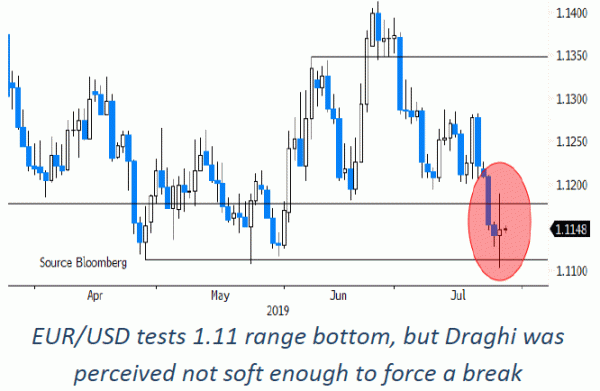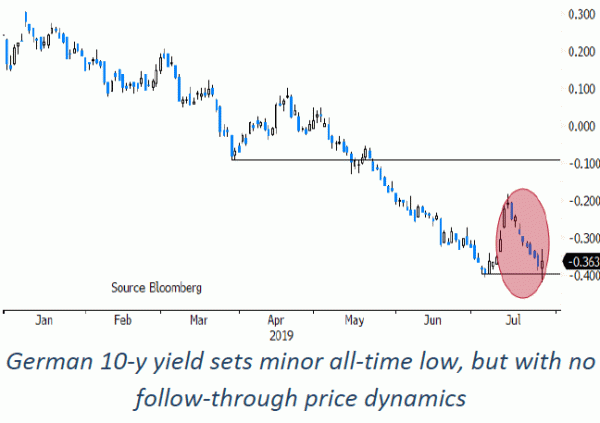- ECB changes its forwards guidance, shifting to an easing bias
- The ECB tasked Eurosystem committees to study options to ease policy further
- The bank expressed its desire for a symmetrical inflation approach
- The bar for further easing in September has become (very) low
- Markets developed a buy-the-rumour, sell-the-fact reaction
The ECB made an important further step to restart policy easing yesterday, most likely at the September policy meeting. Last month, the ECB indicated that it became ever more alert for potential headwinds that might further slow the economy and prevent the bank from reaching its inflation target. The bank went a step further yesterday. It changed its forward guidance to an easing bias as it explicitly said that rates might be lowered. The bank firmly reiterated that it is prepared to take further action if needed. It instructed the relevant Eurosystem committees to examine the options for further easing, another sign that the bank will be ready to ease policy further in September.
The market reaction was a bit complicated as part of the market already saw a good chance of the ECB to cut rates yesterday. European interest rates reached new all-time lows around the time of the announcement of the policy decisions/start of the press conference. EUR/USD tested the key 1.11 support. Even as the ECB showed a strong commitment to act, European interest rates and the euro rebounded as the ECB President gave few details on the composition of a new easing package that will be studied. A classic buy-the-rumour/sell the fact reaction.
ECB facts & decisions
At the July meeting, the ECB left its main policy rates unchanged at 0.00% for the repo rate and -0.40% for the deposit rate. In the run-up to the decision, markets discounted about a 50% chance that the ECB would already act in July as important timely indicators on the economy suggested that the situation was deteriorating at a fast pace, especially in the cyclical manufacturing sector. This July rate cut didn’t happen, but the ECB took several important steps, giving markets a clear signal that a September rate cut is highly likely.
Firstly, the ECB formally changed its forward guidance to an explicit easing bias. The ECB now guides that its main policy rates will remain at their present or lower levels, at least through the first half of 2020. The ECB highlighted the need for a highly accommodative policy stance. If the medium-term inflation outlook continues to fall short of its aim (which is very likely to happen), the ECB is determined to act. The bar for further easing is now even lower than in June/at Sintra when the ECB indicated that it would act in the absence of improvement in reaching its inflation target.
The ECB also made an interesting change in the narrative on reaching its inflation target. The policy statement didn’t say that inflation will have to return to the target of “below but close to 2%”, but instead stressed the desire/commitment to symmetry in the inflation. This change of the language is no formal change in the inflation target (yet?). Even so, the ECB will be happy if inflation would temporarily surpass the 2% target. The ECB signals that 2% is no implicit upper limited and that no immediate tightening is needed in case of a temporary breach. In other words: interest rates can stay lower for longer. The idea of a symmetrical inflation target is in line with the analysis of Draghi at the Sintra ECB forum.
Aside from the change in forward guidance, the ECB didn’t take any ‘hard’ easing measures yesterday. However, it will be ready to do so at the September meeting. It instructed the relevant Eurosystem Committees to examine the options to ease policy further. The ECB specifically mentioned ways to reinforce forward guidance, mitigating measures such as a tiered system for reserve remuneration and options for the size and the composition of potential new assets purchases. If this exercise is done by the September policy meeting, the ECB will be able to make an assessment on a ‘broad’ set of measures at its disposal to reach the inflation target as soon as possible.
In the press conference, Draghi elaborated in debt on the economic context. Global international uncertainty is hurting the manufacturing hard, but employment and wage growth continue to support domestic demand. The ECB still expects no EMU recession. Still, in this environment, inflationary pressures remain muted and inflation expectations have declined.
Regarding monetary policy, the ECB president didn’t gave any concrete details on specific measures that might be taken once the ECB restarts easing. It is not that easy to specifically quantify market expectations on all these topics. However, it looks fair to assume that yesterday’s ECB action was rather close to average market expectations. However, the lack of details probably made the ECB message less ‘aggressive’ than at least part of the market participants had expected/hoped.
Market reaction
Both the EMU interest rate markets and the euro showed some kind of buy-the-rumour, sell the fact reaction.
Markets had largely anticipated a soft ECB. German yields touched new all-time lows (10-yr, -0.42%) at the start of the ECB press conference. However, the decline of yields was (more than) reversed during the ECB press conference. The German yield curve rose 1.8 bp for the 2-y yield to 3.1 bp for the 30-y yield. At least part of the market was positioned for already a rate cut yesterday or at least for a more aggressive/concrete signals on further easing.
EUR/USD rebounded from levels close to the 1.11 level at the start of the press conference to the 1.1185 area, but closed the session little changed at 1.1145. Stretched expecations on further ECB easing also shaped the EUR/USD reaction. At the same time, FX investors were also reluctant to break this important EUR/USD level ahead of today’s US Q2 GDP report and with next week’s Fed meeting still on the horizon. 
The reaction of risky assets (equities, non core bonds) was in line with FX and interest rates. Equities rallied after the publication of the policy statement but fell prey to profit taking after the press conference. In the same move, peripheral spreads initially narrowed further on hopes for substantial further easing but those gains were also reversed later as the ECB president didn’t give any hints on the composition of a potential new asset purchase program.












